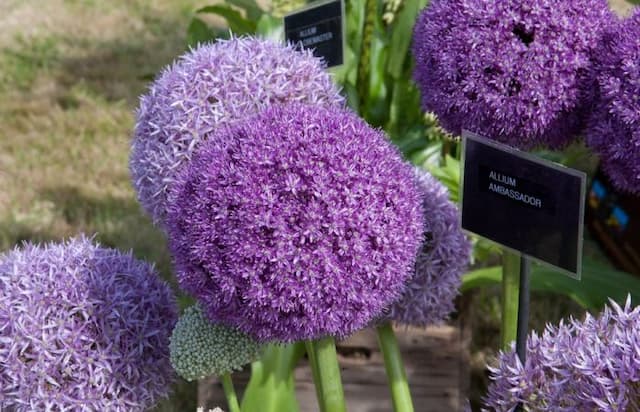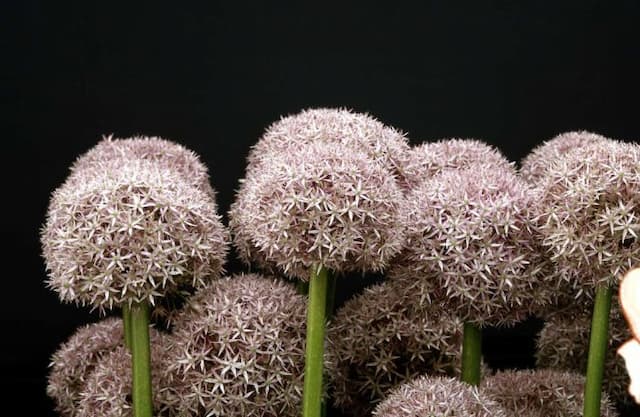Sicilian Honey Lily Allium siculum











ABOUT
The plant known as Allium siculum, commonly referred to as Sicilian honey garlic, is characterized by its distinctive and ornamental appearances. The foliage of this plant consists of strap-shaped leaves that are glossy and green, creating a lush base for the flowers. As for the blooms themselves, they are quite unique and hang in an elegant, bell-shaped fashion. They dangle from the top of a sturdy, leafless stem, forming a loose cluster or umbel that seems to nod or droop, adding to the plant's charm. The flowers of Sicilian honey garlic are typically a combination of colors, blending cream, green, and purple hues. Each individual flower is marked with a subtle yet intricate pattern and often has a contrasting darker stripe running along the middle of each petal, adding to its visual appeal. The buds start off enclosed in a papery bract and, as they bloom, they can exhibit a range of colors from a creamy green to flushes of pink or burgundy. Aside from its flowers, Sicilian honey garlic yields capsule-like fruit which adds another element of interest to the plant. Throughout its blooming season, this plant is also known to attract pollinators, including bees, which adds to its value in the garden setting aside from its decorative qualities. However, size-related specifics and numerical measurements are to be omitted from this description.
About this plant
 Names
NamesSynonyms
Sicilian Honey Garlic, Sicilian Honey Lily, Mediterranean Bells, Honey Lily
Common names
Nectaroscordum siculum, Allium bulgaricum, Allium dioscoridis, Allium siculum subsp. dioscoridis, Nectaroscordum siculum var. bulgaricum.
 Toxicity
ToxicityTo humans
The Allium siculum, commonly known as Sicilian honey garlic, is not considered highly toxic to humans. However, as with many members of the Allium family, it may cause discomfort if ingested in large quantities. Symptoms of ingestion can include gastrointestinal upset, such as nausea, vomiting, and diarrhea. It is important to keep in mind that individual sensitivities can vary, so some people might experience more pronounced symptoms. Generally, accidental ingestions result in minimal toxicity.
To pets
Sicilian honey garlic (Allium siculum) is toxic to pets like cats and dogs, similar to other members of the Allium family. Ingesting this plant can lead to symptoms such as gastrointestinal irritation, drooling, nausea, oral irritation, and abdominal pain. In more severe cases, particularly if consumed in larger quantities, toxicity can lead to more serious conditions such as oxidative damage to red blood cells, resulting in hemolysis, hemolytic anemia, and even organ damage. If you suspect your pet has ingested any part of the Sicilian honey garlic, it is critical to seek veterinary attention promptly.
 Characteristics
CharacteristicsLife cycle
Perennials
Foliage type
Deciduous
Color of leaves
Green
Flower color
Pink
Height
2-3 feet (60-90 cm)
Spread
6-12 inches (15-30 cm)
Plant type
Bulb
Hardiness zones
4
Native area
Europe
Benefits
 General Benefits
General Benefits- Aesthetic Value: Allium siculum, commonly known as Sicilian honey garlic, adds ornamental appeal to gardens with its pendulous bell-shaped flowers.
- Attracts Pollinators: The plant's flowers provide nectar, which attracts bees, butterflies, and other beneficial insects to the garden.
- Drought Tolerance: Once established, Sicilian honey garlic is tolerant of dry conditions, requiring minimal watering and maintenance.
- Cold Hardy: The plant is able to withstand cold temperatures, making it suitable for growing in a variety of climates.
- Ease of Growing: Allium siculum is easy to grow and generally not demanding, which makes it an excellent choice for beginner gardeners.
- Deer and Rodent Resistant: The plant is naturally resistant to browsing by deer and damage from rodents due to its onion-like scent and taste.
- Naturalizing: Sicilian honey garlic can spread and naturalize in suitable areas, filling the space without becoming invasive.
- Culinary Use: Though not a commonly consumed species, some Allium species have edible parts, and Sicilian honey garlic can potentially be used as an herb or garnish.
- Companion Planting: The strong scent of Sicilian honey garlic can help deter pests from nearby plants, making it a good companion in a mixed border or vegetable garden.
 Medical Properties
Medical Properties- This plant is not used for medical purposes.
 Air-purifying Qualities
Air-purifying QualitiesThis plant is not specifically known for air purifying qualities.
 Other Uses
Other Uses- Allium siculum, commonly known as Sicilian honey garlic, is sometimes used in floral arrangements for its unique drooping umbels of bell-shaped flowers that can add an exotic touch to bouquets and centerpieces.
- Its seed heads can be dried and sprayed with metallic paint to create long-lasting, ornamental displays for interior decoration or craft projects.
- Gardeners may use Sicilian honey garlic as a companion plant in vegetable gardens to deter pests, due to its strong onion-like aroma that can confuse insects seeking out specific host plants.
- The plant's tall and structural form can be beneficial in garden design, providing height and visual contrast when planted amongst lower-growing flowering plants.
- The nectar-rich blooms of Sicilian honey garlic can be an asset in wildlife gardens, attracting pollinators such as bees and butterflies, helping to support local ecosystems.
- Some cultures use the stalks of Sicilian honey garlic as natural stakes or markers in gardens, as they are strong, straight, and sturdy when dried.
- The dried seed pods of the Sicilian honey garlic can be used to create natural rattles or noise-makers in crafts and traditional musical instruments.
- Photographers and artists may utilize the unique shape and appearance of Sicilian honey garlic in their works to capture the beauty of its inflorescence, using the plant as a natural subject in photography and paintings.
- Due to their robustness, the stems of Sicilian honey garlic can be woven or braided into small decorative items such as wreaths or garlands for festivals or seasonal celebrations.
- As a teaching tool in botany and horticulture, Allium siculum can demonstrate the characteristics of bulbous plants and the Allium genus to students and gardening enthusiasts.
Interesting Facts
 Feng Shui
Feng ShuiThe Allium siculum, commonly known as Sicilian honey garlic, is not used in Feng Shui practice.
 Zodiac Sign Compitability
Zodiac Sign CompitabilityThe Sicilian honey garlic is not used in astrology practice.
 Plant Symbolism
Plant Symbolism- Unity and Humility: Allium siculum, commonly known as Sicilian honey garlic, is often associated with unity due to its clustered flower heads, symbolizing how many different parts can come together to make a whole. Its understated appearance can represent humility.
- Patience and Perseverance: As a plant that can take some time to bloom and thrives in harsh growing conditions, Sicilian honey garlic symbolizes the virtues of patience and perseverance.
- Good Fortune and Prosperity: In some cultures, alliums are thought to bring luck and are associated with wealth, making Sicilian honey garlic a symbol of prosperity and good fortune.
- Strength and Courage: Its ability to repel pests and diseases can lend Sicilian honey garlic the symbolism of strength and courage, standing tall against adversity.
 Water
WaterThe Sicilian honey garlic requires moderate watering, making sure the soil is moist but not waterlogged. During the growing season, in the spring and early summer, water the plant once a week with about one to two gallons, depending on the soil type and weather conditions. Once the foliage begins to die back after flowering, reduce watering to allow the soil to dry out as the bulb goes into dormancy. Avoid overwatering, as this could cause bulb rot.
 Light
LightSicilian honey garlic thrives in full sunlight to partial shade. The best location for this plant is a spot where it will receive at least six hours of direct sunlight each day. If planted in too much shade, the stems may become leggy and the flowering may be reduced. It's adaptable to a variety of lighting conditions but will do best in bright, indirect light or a sunny spot that gets some afternoon shade in extremely hot climates.
 Temperature
TemperatureSicilian honey garlic is tolerant of a range of temperature conditions but performs best in areas with cool to moderate climates. It can survive minimum temperatures down to around 20 degrees Fahrenheit and is well-suited to growing in USDA hardiness zones 5 through 9. For optimal growth and flowering, maintain a consistent environment where frosts are rare and the temperature doesn't frequently drop below the freezing mark.
 Pruning
PruningPruning is not generally required for Sicilian honey garlic, but deadheading the spent flowers can encourage a tidy appearance and prevent the plant from self-seeding. If desired, remove the flower stalks after blooming, but leave the foliage in place until it yellows and dies back naturally. This allows the bulb to gather energy for next year's growth. Prune only the flower stems, typically once a year after flowering.
 Cleaning
CleaningNot needed
 Soil
SoilHoney garlic (Allium siculum) thrives best in a well-draining soil mix with a pH of 6.0 to 7.0. A blend of equal parts loam, sand, and compost or well-rotted manure will create an ideal environment. Perlite or grit can be added for improved drainage.
 Repotting
RepottingHoney garlic bulbs do not require frequent repotting and can typically be left undisturbed for several years. They may be repotted or divided every 3-4 years to prevent overcrowding.
 Humidity & Misting
Humidity & MistingHoney garlic prefers outdoor conditions where it can receive natural humidity levels. It is quite hardy and does not require specific humidity control when planted in the garden.
 Suitable locations
Suitable locationsIndoor
Provide bright light, cool temps, periodic watering for Honey garlic.
Outdoor
Plant in well-drained soil, full sun to partial shade, for Honey garlic.
Hardiness zone
4-9 USDA
 Life cycle
Life cycleAllium siculum, commonly known as Sicilian honey garlic, begins its life cycle when seed germination occurs, often in autumn or early spring, in a well-drained soil with sufficient moisture. After germination, it develops a root system and foliage in the form of long, strappy leaves, preparing for photosynthesis and growth. As temperature and daylight hours increase in spring, the plant enters its next stage by sending up a tall stem, culminating in an umbel of bell-shaped flowers that range in color from cream to pink, usually appearing in late spring to early summer. Following pollination, often by bees attracted to the nectar, the flowers develop into seed capsules. Once the seeds mature, they are dispersed by wind or wildlife, completing the reproductive cycle. Finally, as winter approaches, the above-ground parts of the plant die back, and it enters a period of dormancy, with the bulb underground surviving the cold to begin the next cycle when conditions are favorable.
 Propogation
PropogationPropogation time
Spring
The Allium siculum, commonly known as Sicilian Honey Garlic, is typically propagated by dividing the bulbs. This method is favored due to its simplicity and effectiveness in producing genetically identical plants. The best time to propagate by bulb division is during the plant's dormancy period in the late summer to early fall, after the foliage has died back. To propagate, carefully dig up the bulbs and gently separate the smaller bulblets from the main bulb. Replant these bulblets around 6 inches (15 centimeters) apart and at the same depth they were previously growing. They should be placed in well-drained soil with ample sunlight. Water the newly planted bulblets to help establish them, ensuring they are not too wet as this could cause rot.









